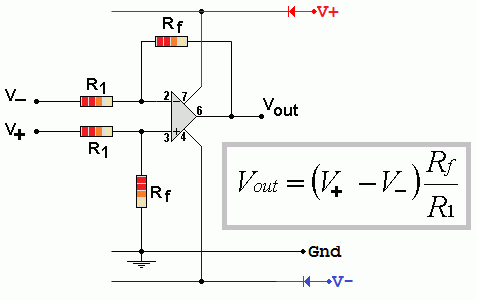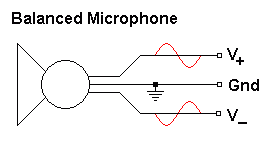

Difference Op Amp |
|
To gain access to revision questions, please sign up and log in.
The difference amplifier (Differential Amplifier) amplifies V+ - V-. For best results, the resistors should be matched or trimmers should be used to perfectly match them.

The input resistance between the two inputs is equal to 2 x R1.
For the Falstad Circuit Simulation, CTRL+Click Difference Amplifier Subtracting two Signals
In options, check European Resistors and uncheck Conventional Current.
Alternatively view Difference_Amplifier.txt.
Save or copy the text on the web page. Import the saved or copied text into the Falstad simulator.
Here is the new HTML5 Simulator Site.
Differential Amplifiers are often used when there is likely to be noise on the input channels. The signal is amplified and the noise is cancelled out. This happens with many transducers that have a small output. Strain gauges are a good example.
Another common example is when a microphone with a long connecting wire is plugged into a public address amplifier. A balanced microphone with two signal wires and a separate ground wire is connected to the inputs.


Microphone + Noise Example
A special balanced microphone is needed for this to work.
When one microphone wire goes positive, the other wire goes negative by an equal amount. If the microphone voltage is V, the amplifier output is V - (- V) = 2V.
If there is noise N, the amplifier noise output is N - N = 0. Thus the noise is cancelled. This relies on the fact that the noise will be picked up equally by both inputs whereas the microphone signal is opposite on each input wire.
Similar reasoning applies to the strain gauge example above.
The charts show two noisy signals. When subtracted from each other, the clean signal remains and the noise is cancelled out.
reviseOmatic V3 Contacts, ©, Cookies, Data Protection and Disclaimers Hosted at linode.com, London